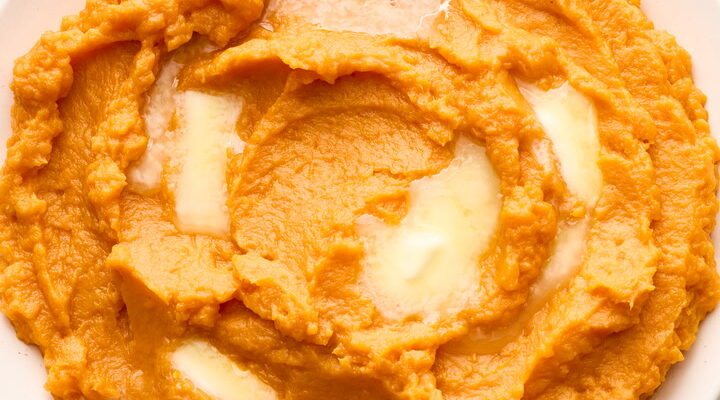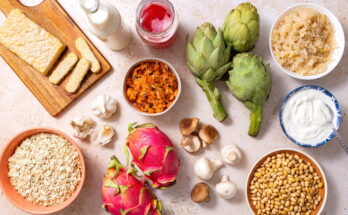Mashed Camote Recipe: Ever found yourself craving something cozy, sweet, and satisfying? Mashed camote, or mashed sweet potato, might just be your new comfort food hero. This dish is rich in flavor, easy to prepare, and incredibly versatile. Whether you’re aiming for a healthy side dish, a festive meal component, or a simple snack, mashed camote delivers. Camote, the Tagalog term for sweet potato, has been a staple in Filipino households for generations. It’s naturally sweet, packed with nutrients, and can be transformed into a variety of delightful dishes—mashed being one of the simplest and most comforting.
Unlike the typical mashed potatoes, mashed camote offers a naturally sweet twist that pairs beautifully with both savory and sweet toppings. From weeknight dinners to holiday feasts, this dish fits any occasion. Plus, it’s gluten-free, budget-friendly, and a great way to sneak in some extra vitamins.
So, ready to dive into this comforting, hearty dish? Let’s get cooking!
Ingredients Needed for Mashed Camote
A great dish starts with quality ingredients. Mashed camote requires only a few simple items, but the final flavor depends greatly on what you choose to include.
Basic Ingredients:
- 3-4 large camote (sweet potatoes) – peeled and cubed
- 1/2 cup milk or coconut milk – for a creamy texture
- 2 tablespoons butter or margarine – adds richness
- Salt – to taste
- Pepper – optional, for a hint of spice
Optional Add-ins for Flavor:
- Brown sugar or honey – for extra sweetness
- Cinnamon or nutmeg – adds a warm, cozy aroma
- Cream cheese or sour cream – for added creaminess
- Chopped herbs (like rosemary or thyme) – if going for a savory twist
- Toasted nuts or fried garlic – for a crunchy topping
The beauty of mashed camote is its flexibility. You can keep it simple or spice it up with your favorite ingredients. Going vegan? Use coconut milk and plant-based butter. Want it sweet and dessert-like? Add cinnamon and brown sugar. Craving something savory? Garlic and herbs are your best friends.
Tools and Equipment Required
Before diving into the recipe, let’s gather our tools. Having the right kitchen gear makes prep work easier and cooking smoother.
Kitchen Essentials You’ll Need:
- A large pot – for boiling camote
- Peeler and knife – for prepping the sweet potatoes
- Colander – for draining water
- Mixing bowl – to mash and mix everything
- Potato masher or fork – to get that perfect mash
Tips for Easier Preparation:
- A sharp knife makes peeling and chopping safer and faster.
- Use a large enough pot so your camote cubes can boil evenly.
- If you want extra smooth mashed camote, consider using a hand mixer or food processor.
Being organized in the kitchen always makes the process more enjoyable. So, prep everything ahead, keep your workspace clean, and let the camote magic happen.
How to Choose the Best Camote
Choosing the right sweet potatoes can make or break your mashed camote. Look for camote that’s firm, smooth, and free from cracks or bruises. Avoid any with soft spots or signs of sprouting—these are past their prime.
Picking the Right Sweet Potatoes:
- Color matters – orange-fleshed camote tends to be sweeter and creamier, perfect for mashing.
- Size and shape – medium-sized camote are easier to peel and cook evenly.
- Freshness is key – fresher camote means better flavor and texture.
Cleaning and Preparing for Cooking:
- Rinse thoroughly to remove dirt.
- Peel carefully using a vegetable peeler.
- Cut into even chunks to ensure uniform cooking.
Clean, fresh camote guarantees your mash will turn out flavorful, smooth, and delicious. Take the time to prep right, and the payoff is worth it.
Step-by-Step Instructions to Make Mashed Camote
Now that we’ve covered the basics, it’s time to get hands-on. This step-by-step guide will walk you through making the perfect mashed camote every time.
Step 1 – Peel and Chop the Camote
Start by peeling your camote. A good peeler will make the job quick and safe. Once peeled, chop the camote into even-sized chunks—about 1.5-inch cubes are ideal. This ensures they cook evenly and mash smoothly. Try not to make the pieces too small or they may absorb too much water during boiling.
Place the chopped camote into a large bowl of cold water while you prep the rest. This prevents discoloration and helps remove some excess starch, giving you a fluffier mash later.
Step 2 – Boil Until Tender
Transfer the chopped camote into a large pot and cover them with cold water. Add a pinch of salt, then bring it to a boil over high heat. Once boiling, reduce the heat to a simmer and cook for about 15–20 minutes. Check doneness by poking a piece with a fork—it should slide in easily without resistance.
Don’t overboil, or your camote might get too watery and affect the final texture. Once tender, drain them well using a colander and let them sit for a minute to release steam—this step is key for a fluffy mash.
Step 3 – Drain and Mash
Once your camote is cooked and drained, return them to the pot or a large mixing bowl. Now comes the fun part—mashing! Use a potato masher, large fork, or even a ricer if you prefer ultra-smooth mash. Start mashing gently, breaking down the large chunks.
At this stage, your mash should be smooth with a few rustic bits if that’s your style. If you want it creamier, you can use a hand mixer, but avoid overmixing to keep the texture light.
Step 4 – Add Butter, Cream, and Seasoning
Now that your camote is nicely mashed, it’s time to enrich it with flavor. Add your butter first—this allows it to melt into the warm camote and blend more easily. Follow this with milk or coconut milk (depending on your preference) and stir well. The combination of butter and milk brings that creamy, dreamy consistency that we all love in mashed dishes.
Taste as you go. Start with a pinch of salt and a little pepper. Then, adjust depending on whether you’re aiming for savory or sweet. For a richer texture, add sour cream or cream cheese. If you want to bring out the camote’s natural sweetness, add a teaspoon of brown sugar or a drizzle of honey. And don’t forget the spices—cinnamon or nutmeg can take your mash to the next level.
The best part about mashed camote is its adaptability. You can create a dish that’s truly your own, just by playing with flavors.
Step 5 – Final Touches and Serving Suggestions
Your mashed camote is almost ready to steal the show. Now it’s all about presentation and pairing.
If you’re going sweet, top it with a sprinkle of cinnamon and a few toasted pecans or walnuts. Maybe even a dash of maple syrup for that indulgent dessert feel. For a savory side, consider fried garlic bits, a dollop of sour cream, or a sprinkle of chopped fresh herbs like parsley or chives.
Here are a few serving ideas:
- With grilled meats – Think grilled chicken, pork chops, or steak.
- As a holiday side dish – A unique alternative to mashed potatoes for Thanksgiving or Christmas.
- In a buddha bowl – Add a scoop alongside quinoa, roasted veggies, and a tahini drizzle.
- As a baby food – Mash extra fine and skip the seasonings for a healthy, natural treat.
Whether you serve it as a side dish, main, or snack, mashed camote is guaranteed to please. It’s colorful, full of flavor, and endlessly customizable.
Health Benefits of Camote
Mashed camote isn’t just delicious—it’s also a nutritional powerhouse. This humble root vegetable is loaded with essential vitamins and minerals that support a healthy lifestyle. When compared to regular white potatoes, camote holds the edge in both flavor and nutrition.
Rich in Vitamins and Minerals
Camote is an excellent source of vitamin A, which is essential for healthy vision, immune function, and skin. Just one serving of mashed camote can provide more than your daily requirement of this powerful antioxidant. It’s also rich in vitamin C, vitamin B6, potassium, and manganese—all vital nutrients that support everything from muscle function to heart health.
High in Fiber
If you’re looking to improve digestion or stay fuller for longer, camote is your friend. Its high fiber content helps regulate your digestive system and can support weight management. Unlike overly processed carbs, the fiber in camote slows digestion, giving you sustained energy throughout the day.
Natural Sweetness Without the Guilt
The natural sugars in camote are released slowly into the bloodstream due to their low glycemic index. This means they’re a great option for people managing blood sugar levels, including diabetics—especially when compared to traditional mashed potatoes or sugary sides.
Gluten-Free and Diet Friendly
Camote is naturally gluten-free, making it an ideal choice for people with celiac disease or gluten sensitivities. It also fits well into most diets, including paleo, vegetarian, and vegan (with appropriate milk and butter substitutes).
Mashed camote proves that comfort food doesn’t have to come at the cost of your health. It’s one of those rare dishes that’s just as good for your body as it is for your taste buds.
Tips and Tricks for the Best Mashed Camote
To truly elevate your mashed camote game, there are a few expert tips you should know. These small adjustments can make a big difference in the taste and texture of your final dish.
Don’t Overboil
Boiling camote too long can lead to a waterlogged mash that’s mushy and bland. Keep an eye on them, and test with a fork around the 15-minute mark. They should be soft, not soggy.
Dry Them Before Mashing
After draining the boiled camote, let them sit in the pot for a minute or two to steam off extra moisture. This helps prevent a runny consistency.
Warm the Milk and Butter
Cold milk or butter can cool down your mash and make it lumpy. Instead, warm them slightly before mixing. This helps everything blend more smoothly and evenly.
Season Gradually
Salt and other seasonings should be added a little at a time. Camote has a naturally strong flavor, so too much seasoning can overwhelm it. Taste after each addition and adjust accordingly.
Use a Mixer for a Creamier Finish
If you prefer your mash extra smooth and creamy, use a hand mixer or a food processor. Just be careful not to overwork it, or it could turn gluey.
By following these tips, your mashed camote will be consistently smooth, flavorful, and crowd-pleasing every single time.
Variations of Mashed Camote
One of the best things about mashed camote is how easily you can adapt it to suit different cravings and meals. Whether you prefer savory, sweet, spicy, or creamy, there’s a version for everyone.
Sweet and Creamy Mashed Camote
Perfect for dessert or a holiday side:
- Add brown sugar or maple syrup
- Mix in cinnamon and nutmeg
- Top with mini marshmallows or toasted pecans
Savory Mashed Camote
A great side dish for meats or as a hearty lunch:
- Stir in roasted garlic or caramelized onions
- Add herbs like thyme, sage, or rosemary
- Top with cheese or a pat of herb butter
Spicy Mashed Camote
Ideal if you love a little heat:
- Add chili flakes or cayenne pepper
- Mix in chipotle peppers in adobo sauce
- Garnish with sliced jalapeños
Dairy-Free and Vegan Mashed Camote
All the flavor without the dairy:
- Use coconut milk or almond milk
- Replace butter with olive oil or vegan butter
- Add nutritional yeast for a cheesy flavor
The versatility of mashed camote makes it a go-to recipe that can be reinvented countless times. Get creative and try different combinations based on what you’re craving or what’s in your pantry.
Common Mistakes to Avoid When Making Mashed Camote
Even the simplest recipes can go sideways if a few small details are overlooked. Let’s cover the most common mistakes people make when preparing mashed camote—and how to avoid them.
1. Using the Wrong Type of Camote
Not all sweet potatoes are created equal. For a smoother, creamier mash, orange-fleshed varieties are your best bet. White-fleshed camote tends to be starchier and drier, which can affect the final texture.
2. Cutting Uneven Chunks
When your camote pieces are all different sizes, they cook at different rates. Some end up mushy, while others stay hard. For even cooking, chop the camote into uniform chunks—about 1.5 inches thick.
3. Not Draining Properly
Leaving too much water in the camote after boiling can make your mash watery and bland. Make sure to drain them completely, and let them sit for a minute or two in the pot to steam off excess moisture before mashing.
4. Adding All Ingredients at Once
Dumping in all your butter, milk, and seasonings at once can create uneven flavor and texture. Gradually incorporate each ingredient, mixing and tasting as you go.
5. Overmixing the Mash
This one’s a biggie—overmixing your camote, especially with a blender or food processor, can make the mash gluey and gummy. If you prefer ultra-smooth, mix just until creamy, then stop.
Avoiding these mistakes ensures your mashed camote is fluffy, flavorful, and crowd-approved every time.
Storing and Reheating Mashed Camote
Got leftovers? Lucky you! Mashed camote stores beautifully and reheats just as deliciously with a few tricks.
Storing:
- Let the mash cool to room temperature before transferring to an airtight container.
- Store in the refrigerator for up to 4 days.
- For longer storage, you can freeze mashed camote for up to 2 months. Use freezer-safe containers or resealable bags.
Reheating:
- Microwave: Place in a microwave-safe dish, add a splash of milk or water, and cover. Heat in 30-second intervals, stirring in between.
- Stovetop: Reheat in a saucepan over low heat. Add a bit of milk or butter to refresh the texture.
- Oven: For large batches, reheat in a covered baking dish at 350°F (175°C) for 15–20 minutes.
Mashed camote tends to thicken when chilled, so don’t be afraid to loosen it up with a little liquid during reheating. It’ll taste just as good (if not better!) the next day.
FAQs about Mashed Camote Recipe
1. What is camote?
Camote is a type of sweet potato commonly found in the Philippines and other tropical countries. It has a naturally sweet flavor and comes in various colors, including purple, orange, and yellow.
2. Can I use regular sweet potatoes instead of camote?
Yes, you can substitute camote with regular sweet potatoes. However, the flavor and texture might vary slightly depending on the variety you use.
3. Do I need to peel the camote before boiling?
While it’s optional, peeling the camote before boiling makes the mashing process easier and faster. If you prefer, you can boil it with the skin and peel afterward.
4. How do I make mashed camote creamy?
To get a creamy texture, add butter, milk, or cream while mashing. You can also use a blender or food processor for an ultra-smooth finish.
5. Is mashed camote healthy?
Yes! Camote is rich in fiber, vitamins A and C, and antioxidants. It’s a great option for a nutritious side dish, especially when prepared with minimal added sugar or fat.
6. Can I make it ahead of time?
Absolutely. You can prepare mashed camote in advance and store it in an airtight container in the refrigerator for up to 3 days. Reheat it gently before serving.
7. Can I make mashed camote vegan?
Yes. Use plant-based milk and vegan butter to keep the dish dairy-free and vegan-friendly.
8. What dishes pair well with mashed camote?
Mashed camote pairs well with grilled meats, roasted vegetables, or as a sweet base topped with coconut cream and cinnamon for dessert.
9. Can I freeze mashed camote?
Yes, you can freeze it. Let it cool completely, then store in a freezer-safe container for up to 2 months. Thaw and reheat before serving.
10. How do I avoid lumpy mashed camote?
Boil the camote until very tender and mash while still hot. Using a potato masher, ricer, or blender helps ensure a smooth, lump-free texture.
Conclusion
Mashed camote is more than just a side dish—it’s a cozy, nutritious, and endlessly customizable comfort food. Whether you prefer it sweet or savory, simple or dressed up, this dish fits effortlessly into any meal. With just a few ingredients and some basic kitchen tools, you can whip up a bowl of creamy, flavorful goodness that’s both satisfying and nourishing.
So next time you’re looking for a twist on traditional mashed potatoes, go for mashed camote. Your taste buds (and your body) will thank you.



